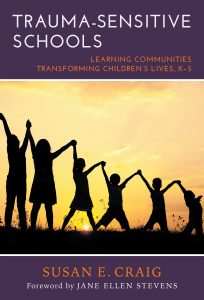From Education Week Teacher > Classroom Q&A With Larry Ferlazzo
How can educators best learn about–and respond to–trauma that students have experienced or are experiencing?
Response From Susan E. Craig
Susan E. Craig, Ph.D. is a lifelong student of trauma’s effects on children’s learning. She is the author of Reaching and Teaching Children Who Hurt: Strategies for Your Classroom (2008) and Trauma-Sensitive Schools: Learning Communities Transforming Children’s, K-5. Her new book Trauma-Sensitive Schools: Havens of Resiliency and Hope, 6-12 will be available in 2017:
Learning about the prevalence and effects of childhood trauma is a little like learning the existence and effects of global warming. The science is there but it so threatening to traditional beliefs about children’s learning and behavior that many educators find it difficult to accept. The fact that four in ten children are maltreated, as well as the documentation that these experiences alter children’s neural development, are shocking. Yet this is the reality teachers and school administrators must address if they intend to meet the instructional needs of the children enrolled in their schools.
Maintaining an unflinching awareness of the prevalence of childhood trauma is the first step in learning how to respond in a trauma-sensitive manner. This allows teachers and administrators to approach challenging behaviors from a stance that is more interested in understanding what’s happened to a child to cause his behavior, than judging it as willful or defiant.
Professional development that focuses on the effects of trauma on neural development and learning is nonnegotiable. It can take a variety of forms: formal training by professionals knowledgeable this area, professional learning communities studying books such as Trauma-Sensitive Schools: Learning Communities Transforming Children’s Lives; or accessing information through social media.
Responding to students with trauma histories is most successful when teachers understand the dynamic of reenactment, know how to manage the “double struggle”, and can move beyond contingency reinforcement to embrace more holistic behavior management strategies.
Reenactment is a largely unconscious process that is activated when children with trauma histories either lash out at teachers in an effort to engage them as the persecutors in past traumatic experiences, or place them in the untenable position of rescuing them from a past that has already happened and can’t be changed.
Reenactment behaviors occur when teacher efforts at student engagement inadvertently trigger traumatic memories. Physical proximity, criticism, or unfair consequences unleash extreme student reactions. Their intensity can easily pull teachers into repetitive interactions with children that are reenactments of past traumas rather than responses to events happening in the present. When teachers know how to manage the “double struggle” of controlling their own reaction to an outburst while de-escalating the child’s behavior, they help children break the reenactment cycle. They come back to the present and are able to accept the teacher’s efforts at collaboration and support.
The intense reactions that characterize the behavior of children with trauma histories are seldom volitional or within their power to control. Rather, they are triggered by unnamed memories that cause the brain’s attention to downshift to a survival mode. The fear that accompanies the “fight, flight, or freeze” response of the lower brain is incapable of reasoning. Efforts to reign in the behaviors through contingency reinforcement are ineffective in the face of such a visceral response to the experience of terror. Instead, regaining control requires helping children achieve a tolerable level stress level. Holistic strategies such as yoga, deep breathing, chanting, drumming or rocking are effective in doing this. Once children calm down, they are able to collaborate with trusting adults about any harm that may have been caused by their behavior and make the necessary amends.
Managing the behavior of traumatized children requires a high degree of compassion, self-discipline, and a trauma-sensitive skill set. But the skills can be taught, and the issues addressed in a manner that benefits both staff and students. But only when schools accept the enormity of the problems facing children rather than wishing them away.

